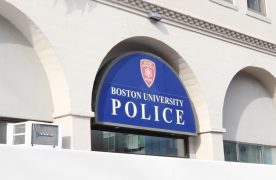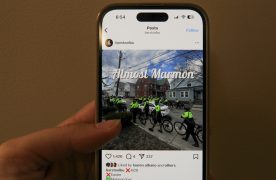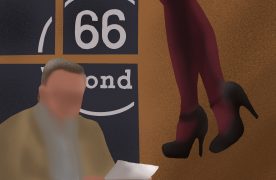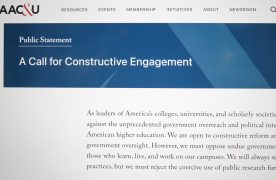A year ago, a Matignon High School senior in Cambridge who asked to be called David had a lot going for him, recalled a fellow Matignon student, who asked to be called Jane. He had friends, good grades and an admittance letter to Harvard University for the fall.
Then David began snorting cocaine. Although the drug-induced high did not hurt his scores in high school, his experience at Harvard was different. With mounting emotional problems and dropping grades, David was forced to drop out of Harvard and check into rehab, Jane said.
David’s experimentation with cocaine and brief habit formation was not unique. A recent survey distributed by the Massachusetts Department of Public Health indicates three times as many middle school students and twice as many high school students are using the drug now than they were in 1999.
The survey, taken by 3,000 students in 50 middle schools and 50 high schools across the state, found that 5.6 percent of middle school students and 5.8 percent of high school students had used cocaine within the past month. In 1999, the percentages were 1.6 and 2.9 respectively.
High school students in suburban locales said cocaine use was becoming more apparent while students closer to the city reported less use of the drug, according to the report.
Christina, who declined to give her last name, was not surprised by the recent surge of cocaine. As a junior at Martha’s Vineyard Senior High School, she recalled a female student last year that regularly used the drug.
‘She was using a lot of drugs it was getting out of control. She became violent and pulled a knife on someone at school. She had to go to rehab after that,’ the 17-year-old said.
Although the student was an extreme case for the school, Christina estimated 15 people from her school, which has classes of about 100 students, did cocaine. She said those students were in the junior and senior classes.
Jessica, a college freshman who declined to give her last name, attended Martha’s Vineyard High School a year ago. She claimed cocaine was most popular for party-going girls.
‘I think peer pressure and popularity are big factors. You’ll see the same popular girls who always show up at the parties doing it. They’re popular, they can afford it, and they can get away with it,’ she said.
Jane, from Matignon, said she felt the trend reported in the study was in line with usage at her school. She estimated 20 students from the upper grades of about 75 students each had tried cocaine.
The small private Catholic school is attended by mostly middle class students who know each other well, Jane said. As she grew older, she noticed a shift in the type of drugs students used.
‘When I was a freshman, a lot of people were using ecstasy. But by the time I graduated, people started using cocaine and Oxycontin,’ she described.
Oxycontin, a prescription painkiller, was abused by about 50 of the 11th and 12th graders when Jane graduated in 2001, she said. Jane added that marijuana was always a popular drug and that some students had begun to lace the marijuana with cocaine.
According to Jane, many of the students who experimented with cocaine were secretive about their habits.
‘Drugs like pot are more widespread, so it’s not a big deal. But the people who were using coke kept it on the down low because they know it’s more serious, and they can get in a lot more trouble for it,’ she said.
At John Winthrop High School in Allston, students dismissed the statistics.
‘The school’s on lockdown. Every morning they check us for drugs, knives and guns. In four years I haven’t seen anyone caught with that,’ senior Francisca Claret said, referring to cocaine.
Winthrop High junior Tony Escapa estimated one out of 300 students used cocaine at the school.
‘That’s pretty strange,’ he said, commenting on the reported use increase. ‘It’s definitely more of a quiet thing if they’re doing it.’
Students from all of the high schools agreed cocaine usage was most common among juniors and seniors. The students said marijuana was the most commonly used and accepted drug.
None of the students had heard of any middle school students experimenting with cocaine. Their bafflement at the middle school usage is shared with school officials and the Drug Enforcement Agency.
Jonathan Palumbo, a representative for the Boston Public School District, said he was shocked by the trend.
‘This isn’t something I’ve heard or seen at all,’ he said. After contacting various school officials, Palumbo reported no school officials in the Boston area complained of problems with the drug.
‘Nobody seems to know anything about it. I’ve seen the numbers, but I have no idea where this is a problem,’ he said.
For public schools in the Boston area, Palumbo reported a slight increase in cocaine charges. So far this year, there were three cases. Last year, there was one case reported, and in 2000, no cases were reported.
Dan, an officer who works for the DEA and asked to keep his last name secret because of the undercover work he did was taken aback by the survey.
‘Wow, middle schoolers?’ he asked. ‘We normally deal with a much older demographic than that. I guess they’re getting it from older siblings,’ he speculated.
Dan said cocaine was expensive or cheap depending on the drug’s purity. He said he believed the type of cocaine middle schoolers could get access to would have to be very diluted. It is more likely for high school students to have access to the drug, according to Dan.
‘The older you get, the more money you have to access and buy the drug,’ he said.
Dan said it is getting easier to obtain cocaine.
‘There are a lot more dealers on the streets these days. Most of the transactions are trunk to trunk and take place in empty parking lots and mall lots,’ he added.
The average age of those charged with cocaine possession and trafficking in Boston was 25, according to Lt. John Armstrong of the Boston Police Department. He speculated the arrests do not necessarily reflect the age of users, since targeted drug traffickers are often older than users of the drug.
The increase in cocaine falls in with national levels. The 2001 National Survey on Drug Abuse found that the nationwide use of cocaine jumped from .05 percent in 2000 to .07 percent in 2001. Almost one-fifth of the nation’s 18 to 25-year-olds said they used illicit drugs in the survey.
This is an account occasionally used by the Daily Free Press editors to post archived posts from previous iterations of the site or otherwise for special circumstance publications. See authorship info on the byline at the top of the page.












